The Aircraft Carrier Alliance have provided a status update regarding the sea trials of new carrier HMS Prince of Wales.
The builders say that HMS Prince of Wales had her first taste of rough seas as she began her second fortnight of trials.
“Among the first tests the 65,000-tonne warship faced on her return to open water was handling in rough weather: the 920ft-long carrier faced a Sea State 6 (waves up to 20ft high), but carved through them relatively untroubled.”
Following one of her planned stops in the Scottish port of Invergordon to re-fuel and store the ship, HMS Prince of Wales has since returned to the North Sea to resume her sea trials programme.
“The ship has already achieved a top speed of 25 knots as her machinery and propulsion continues to be tested. The sea trials programme has been designed to test the full spectrum of her vast and complex systems including the monitoring of speed, manoeuvrability and power and propulsion.”
Commenting on the ships first couple of weeks of trials, Simon Lister, Aircraft Carrier Alliance Managing Director said in a release:
“HMS Prince of Wales is progressing well through her trials programme, this has been our first real opportunity to put the carrier’s outstanding capability to the test, demonstrating the best of British engineering and manufacturing. I am pleased to say that the ship is performing as expected and the industry and RN teams are working well together as we put the ship through her paces”.
According to the ACA, during the first fortnight of trials, the trials team have accomplished:
- The first helicopter landing (a Merlin Mk2 of 820 Naval Air Squadron);
- The first test of engines at full power (reaching a top speed of over 25kts);
- The first test of long-range radar (courtesy of two RAF Typhoons from Lossiemouth);
- The first port visit to take on supplies (fuel/stores) in Invergordon
- Completion of a further 200 compartments on-board, these have been accepted at sea by the MOD Delivery Acceptance Team. There are now just 450 compartments of the 3013 on-board to put the finishing touches to before their final acceptance inspection.
- Completion of the Forward Aircraft Lift dynamic load trial moving a 105 tonne test load through its full operating cycle.
- The first test of the ship’s rugby union side (against Ross Sutherland RFC, who play in the sixth tier of Scottish rugby) – a 20-20 draw with man-of-the-match AB Jack Rutherford bagging three tries.
- The first launch of a weather balloon by the meteorological team; it reached 70,000ft – more than 13 miles up… and 20,000ft higher than the ceiling of the ship’s F-35 Lightning jets;
- and the first test of the ship’s small-calibre guns.
Further resupplies in Invergordon are lined up before HMS Prince of Wales turns south for her future home of Portsmouth next month, followed by formal commissioning before the end of the year.





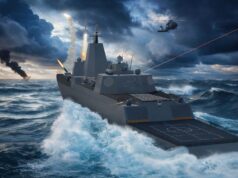
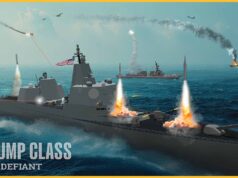
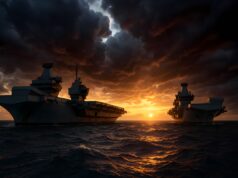
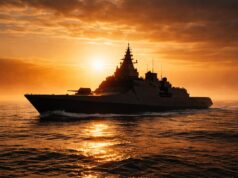

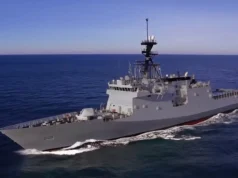
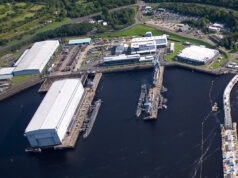

Is this all still part of the maiden voyage?
No, this is testing before being accepted into the Royal Navy. She is still under the Blue Ensign, only when she is commissioned and then goes to sea under the White Ensign will she commence her maiden voyage.
I think when she leaves Pompey that will be her official maiden voyage. At which point every yachtsman in the silent will force a dip the flag event, celebrate with a rum – more likely G&T then scratch their 34ft boat upon return to their pontoon in the gamble or gosport – so I’m told
silent = Solent it will be anything but silent
Explain “dip the flag” event, i’m Vaguely aware of it but can’t remember the detail
Its a mark of respect to the RN, a yacht or merch will lower their ensign, the RN vessel will lower (or dip) their ensign then raise it, then the yacht or merch will raise theirs. Its a sort of salute basically and a pain in the hoop for the signalman.
“Some of you reading this may note however that the ship exceeded the “top speed” on trials multiple times and hit around 30 knots”
Your original article said 32 knots which was, and is, ridiculous.
It is not ridiculous Queen Elizabeth reached 31.9knts last year.
No she didn’t.
Was that not just based upon one AIS estimate? Any other sources to your knowledge at all, Jon? Still, even at a basic 25 knots in the North Atlantic most days, faster but of necessity smaller vessels could be hard pressed to maintain station over a long stint.
Regards
Ron. Were you onboard at the time? And know from first hand experience that it did not happen ? Please share with everyone
Naval architecture 101: she doesn’t have enough power for 32 knots.
Well thats what she achieved whatever Naval architecture 101 says
Ron5 is a very well known American troll, who frequents British military websites.
Naval Architecture 101: hull form is just as, if not more important for top speed than just power.
Ooohhh yes it did ! ?
and actually it was reported on ukdj and 4 other outlets incl op360 and a US site. Speeds achieved
27
29
&…………… 32 !
May I respectfully suggest you recycle and move on to Naval Architecture 102
You might want to read the opening article, UKDJ is now saying 30 knots.
The Royal Navy said 32kts. I’d believe them over a faker like you.
i didn’t bother I just knew I could rely on you to step in and note then down ?
While not conclusive, I’ve been onboard A. N. Other RN vessel coming out of build that was claimed to have made more speed than she was capable of, its not outwith the realms of possibility that if they tell porkies once, they might be doing it again. In fairness, its probably not just the RN that are prone to exaggeration on this stuff.
There’s several to chose from.
For years folks claimed Type 23’s were capable of 34 knots based on a bad reading during trials.
And then there’s the Tide tankers which even today, the RN claims are capable of 27 knots. The actual requirement was for 15 knots sustained, 27 knots is well beyond their capability.
And there’s the US nuclear carriers which a horde of folks will claim can do 40 knots.
The underwater hull paint is a big factor. As the paint is a silicon Anti Foul it will get cleaner the quicker you go until the majority of the marine growth falls away.
Modern Hull paints such as Intersleek or X7 save up to 10 percent on fuel costs because they reduce the hull drag, allowing you to achieve a set speed for less applied power. Inversely this means you have more power to achieve a higher speed.
The top speed is a nice to have and something record in the log but it is rarely used. The hugh fuel consumption curve, the vibration through the hull and propulsion system and the sea state reduce its application to pretty much zero in real world ops.
Fascinating insights. Gone are the days of cleaning away barnacles whilst in dry dock
what was that?
A Nelson era punishment where the offender was dragged by rope under the keel and back up the other side. Due to the barnacles etc on the hull, the poor wretch would have been cut into ribbons.
These paints, which aren’t so new anymore, enable speeds to be maintained as the ship gets older. They do nothing for ships fresh out of build. Like the PoW.
They are new as the formula is constantly evolving. x3 to x5 and now X7 are example from one well known paint manufacturer.
POW was probably designed with the older Anti Foul paints that where not self cleaning so it has gained an advantage through the use of Silicon based Hydro Gel paints.
Modern paints help to reduce fuel consumption by making the hull ” slippier” through the water so you can achieve the speed you set on the bridge by using less power. By not allowing/reducing marine growth to cling to the vessel they help reduce the increase in fuel consumption against power needed for a set speed. Paints and a few other modifications to props are found in the commercial world and are used to reduce fuel consumption by something approaching 15- 20% which for a operator like Maersk is a huge saving in costs.
RN vessels have a maintenance trial that is mandated to compare the fuel curve against power settings. It is used to give a good indication that the hull may b foul and it needs cleaning.
If the hull is clean you use less fuel …you also have more power available for speed. Yes it doesn’t translate into much speed but a knot here or there is possible.
Doing donuts in an aircraft carrier, now that’s how you do testing.
It looks like a nice tight turn doesn’t it! But I bet there’s a good 1200 yards between the inward and outward wakes once the turn is completed! That helo is quite far away I reckon 🙂
I think that the top speed of 32 knots is easily achievable- the designers only stated a top speed of 28 knots to down play the hull and engines twinned capabilities.
These vessels truly are awesome. Just wished the bean counters at the treasury would allow more than 48 f35Bs to be ordered- we are going to need at least double that number to return some fighting prowess to the fleet air arm and RAF.
28kts has been stated as the designed top speed for RN first line ships since at least the 1960s. Its the minumim top speed the RN requires a task group to sustain. However we all know that many ships and classes have been able to exceed this (the T21s could get up around 40kts for short sprints), and I’m sure the QNLZ can make 32kts, even if 28kts makes more sense over a sustained period.
hi’ im sure i read somewhere of a type 23 being measured point to point when the Capitan was showing off. doing a staggering amount above official top speed
regards
A certain T22 on both Oly’s, in hand control and a rag over the shaft torque gauge managed a sedate 35 knts on families day. There was more available if the governers where removed and you didn’t mine screwing up the gearboxes…
138 is the number at the mo, the amount of mo eh that goes back into the treasury due to work share is staggering.
All F35b, for through life attrition.
Tempest has at the moment swept aside an F35a purchase. Especially with the Japanese, Swedes on board.
The Japanese have shown massive Intrest in developing meteor. Imagine ALARM on steroids that can be re tasked to intercept enemy aircraft!
Well Mr Bell, you might be surprised to learn that the designers didn’t claim 28 knots. They actually claimed 25 knots.
Wow. Really bad.
Did you not see the MoD Police Portsmouth Marine Unit? They are armed.
Are you sure about that? As far as I am aware all MOD police officers are fully trained in use of firearms and armed guard is one of their primary duties!
I am also pretty sure I have seen armed personnel on board berthed ships at Portsmouth.
Just what I was about to reply Lee.
Andy, that is not correct I’m afraid. The MoD Police are firearms trained. Aldermaston, Burghfield, Porton Down, Coulport, as just 4 examples amongst the most well guarded sites in the country have armed MoD Police.
MDP also have special units which are mobile and cover a wider region rather than just individual sites.
The MoD Police have a Marine Unit and others based at Portsmouth.
You also have the MPGS, while not MoD Police, who are ex regulars and armed.
The ones who are not armed are the MoD Guard Service who man entry points.
I have seen them on the ship walking around. I was there only last year.
The RN constantly assesses the potential terrorist threat to it’s vessels alongside in the UK and abroad. There is a much broader assessment of potential threats, other than what you see in pompy harbour on a daily basis Just be because you got close in a small boat, doesn’t mean we are going to loose a ship to a terrorist threat. Portsmouth is a busy waterway, with many civvy vessel movements daily. If we had intelligence of a potential threat, you would see a considerable increase in patrols, MOD police and armed upper deck sentrys on the vessels 24hrs a day. Or they would put to sea, if a major attack was imminent.
Rugby? -Prince of Wales rule 1. kick the ball into touch, you go get your own ball back.
Its governed by the Purple Matrix document the recommends the Force Protection posture and responses that the vessel must take in a given location.
In Pompie and Guz you have Armed Sentries who’s rules of engagement are quite clear. Add to that MOD Plod in their boats(they are armed) and a comprehensive CCTV system and other “stuff” then the vessels are adequately protected.
in other area (abroad) other steps in FP are taken that increase protection and help to deter attacks.
Regarding the USS Cole, a RN vessel was in the area at the time and it had armed sentries on the upper deck and the guns where manned. It is believed that this deterred the attackers from going for an RN vessel.
Gunbuster explained it perfectly. He is ex RN I understand, as am I. I carried out upperdeck sentry duties many times alongside in foreign ports, including September 11th 2001, alongside in Malta, onboard HMS Illustrious.
Well has been since I joined in 1999 alongside in foreign ports, and they would do it alongside in pompy if the terror threat required it, and it is standard practice in Faslane for jack to stand armed guard on our SSN’s
I mean, things probably change over time. But the guy I know who was in the RN in the 80s certainly tells me he did guard duty with rifles when in certain ports.
These days there are many ways to combat the threat. I imagine a combination of CCTV, intelligence analysis and guarded ports mean that visible armed presence is not always necessary. I also imagine that in UK ports the port itself is monitored rather than single ships. You do not see armed guards on US ships in US ports. Also I guess that some foreign countries see armed guards as bad form and so the RN needs to deal with things diplomatically too. It is quite complicated as opposed to fixed location RAF and Army bases.
I was a Aircraft Handler Fleet Air Arm for 14 years, I stood upper deck sentry duties alongside with a SA80 A2 by my side. Sailors definitely stand guard duties.
I’m guessing things have changed a tad Andy since your days on the Blake. Who’d have thunk it.
Well you Girls below certainly find enough to scratch each other eyes out.
Who do we believe ,im confused , Just say its 25 knots and if anything extra comes to light we all be delighted